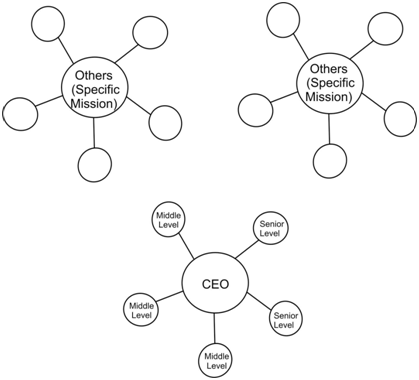Cluster Organisation:
An organisation might be restructured around certain clusters which are inter- locked/networked representing a cluster organisation. Every cluster consists of a group of people drawn from various functional and staff areas working together on a semi-permanent basis to accomplish certain preset goals. A cluster handles their administrative functions, develops the needed expertise, associates to customers, and is accountable for its actions. Every individual inside the cluster has responsibility for his/her particular field of activity and also of the performance of the cluster as an overall.
Individual clusters in an organisation might differ in size consisting commonly of 30 to 50 members to give for a broad range of functional and staff expertise. Inside itself a cluster might have smaller teams of 5 or more individuals to facilitate its work.
A classical cluster organisation would have a number of interlocked circles along with the CEO at the centre and the senior and center level management in adjacent circles although others are grouped around in a number of independent clusters (every cluster along with a exact mission or reasons.)

Figure: Cluster Organisation
Table: Advantages and Disadvantages of Cluster Organisation
|
Advantages
|
1. Well described responsibilities.
2. This structure empowers the employee through fostering individual and team work.
|
|
Disadvantages
|
1. Employees within this structure work on a semi- permanent basis. The state of being not employed on a permanent basis through the organisation might depress the employees and dampen their initiative.
2. A cluster, that manages all the activities related with accomplishing their corporate goals may lose speciality.
3. There is lack of formal hierarchical structure, that may lead to lack of direction in the organisation.
|